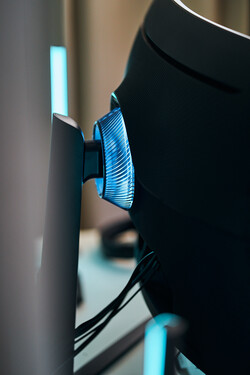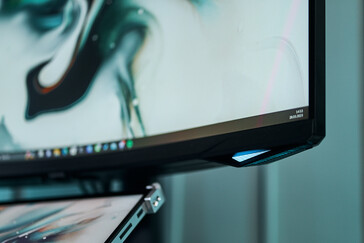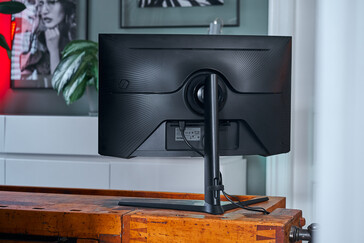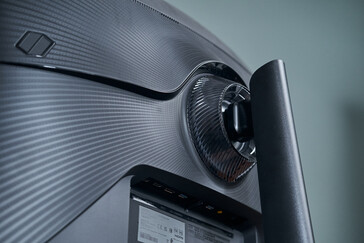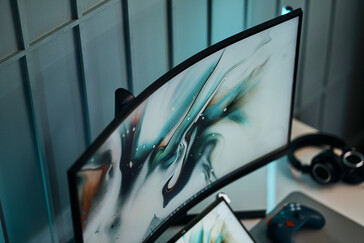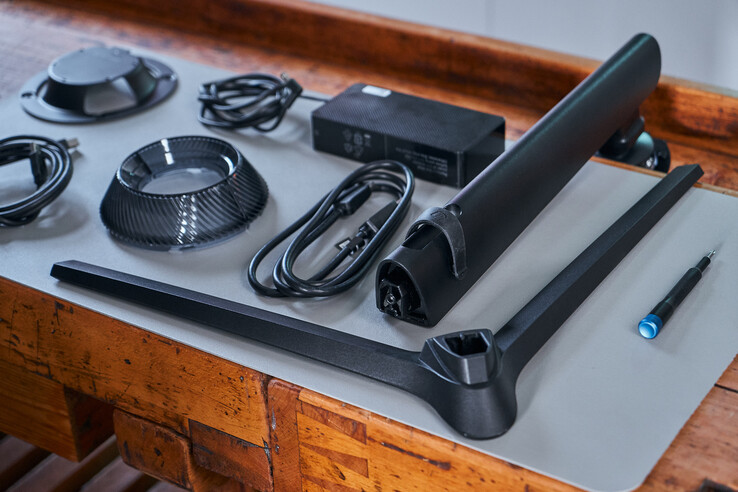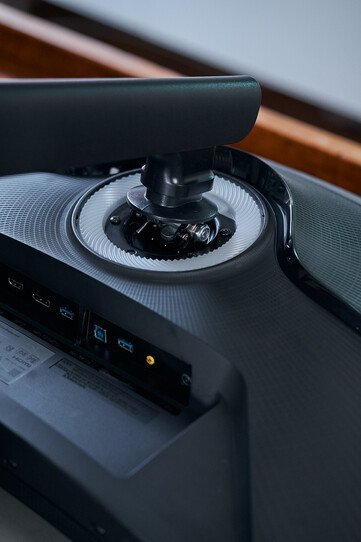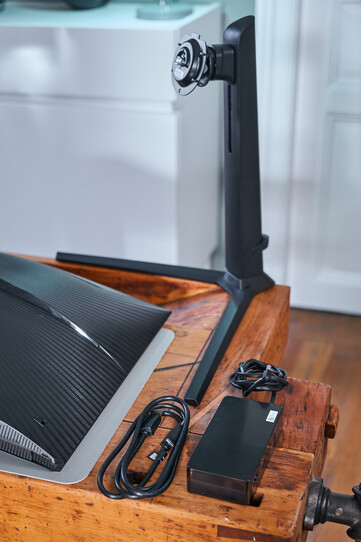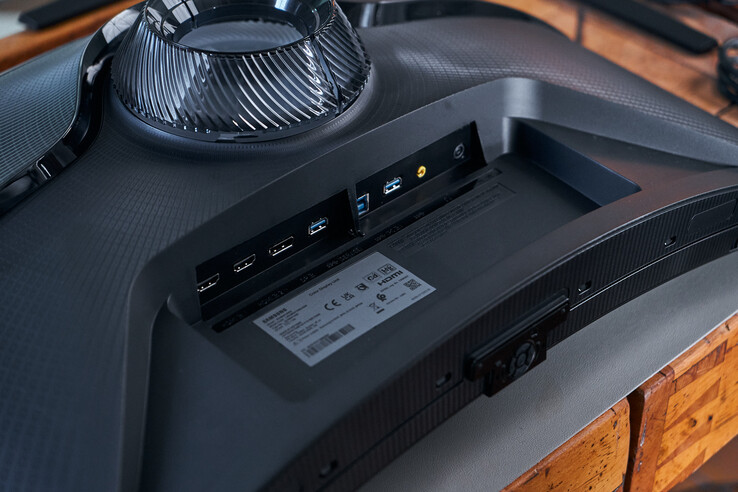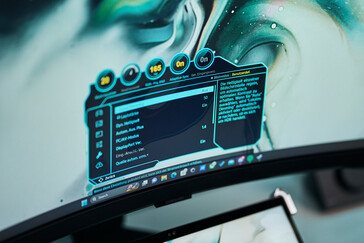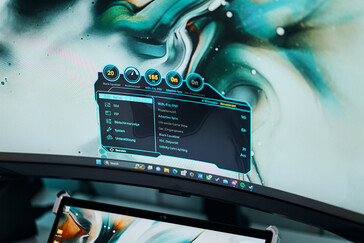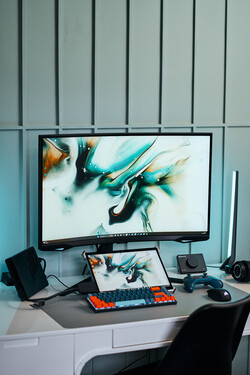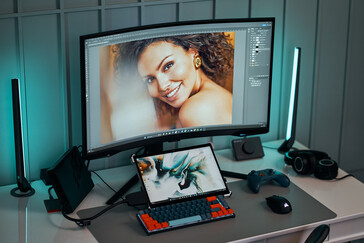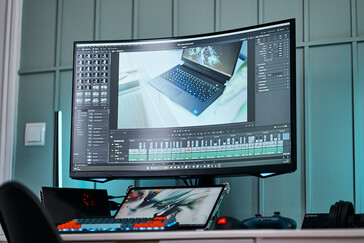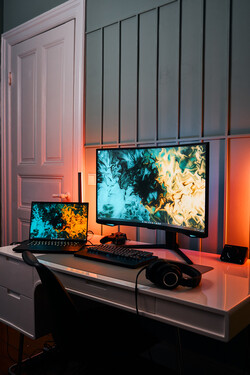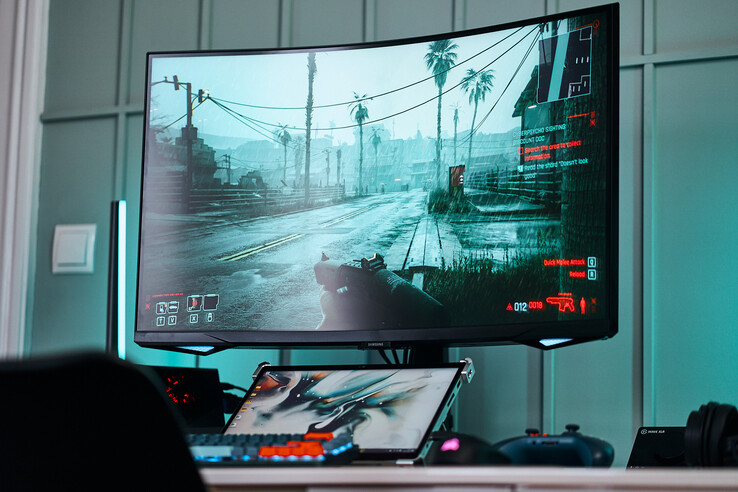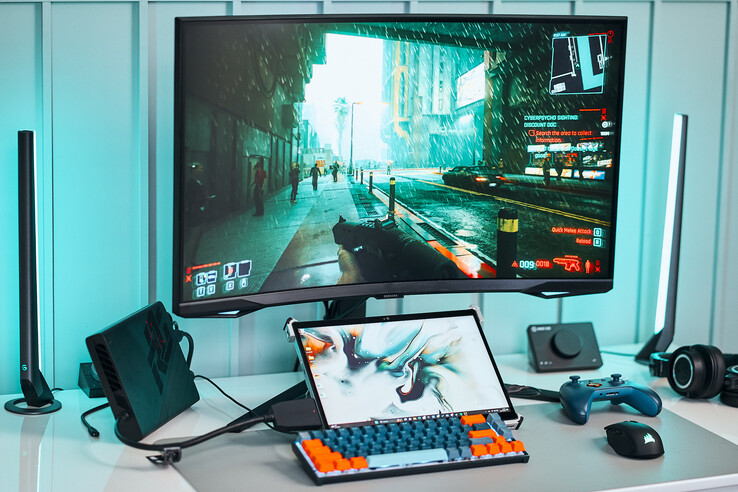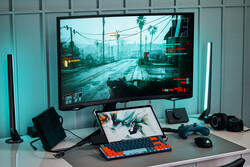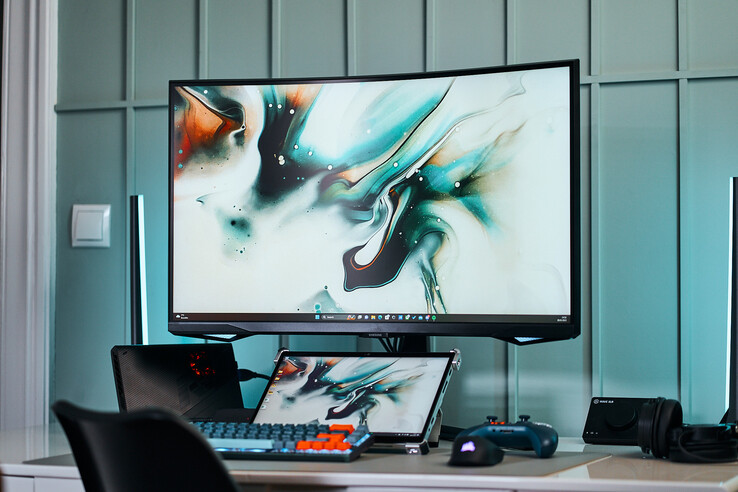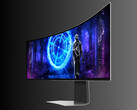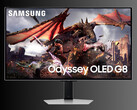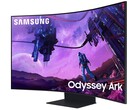Samsung Odyssey Neo G7 review - All-round gaming monitor takes the bend
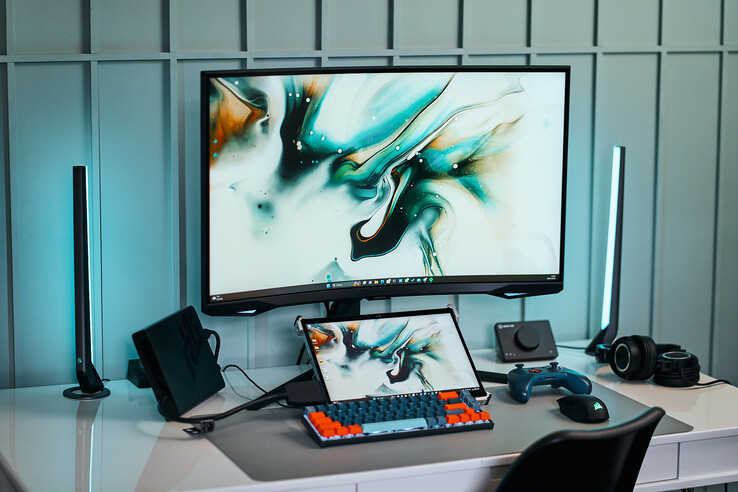
Just a few years ago, 4K monitors with high refresh rates were difficult to justify or even recommend, both economically and technically. However, with the launch of the current GPU generation, both from Nvidia and AMD, high resolution and high refresh rate have moved significantly closer together or even go hand-in-hand in the top models. Thus, monitors like the Odyssey Neo G7 with over 4 million pixels and up to 165 Hz make perfect sense. Samsung not only packs all sorts of useful features into the high-end display but the VA panel is supposed to shine especially bright and offer deep black levels due to the mini-LED backlight. The very aggressive 1000R curvature is supposed to provide absolute immersion in current video games.
We used the monitor for gaming as well as for photo and video editing and describe our experiences and results in a review.
Possible competitors in comparison
Rating | Date | Model | Weight | Height | Size | Resolution | Price |
|---|---|---|---|---|---|---|---|
v (old) | 08 / 2023 | Samsung Odyssey Neo G7 | 32.00" | 3840x2160 | |||
v (old) | 04 / 2023 | Philips Evnia 34M2C8600 | 34.00" | 3440x1440 | |||
v (old) | 02 / 2023 | KTC KTC G42P5 OLED | 42.00" | 3840x2160 | |||
v (old) | 07 / 2023 | Philips 45B1U6900C | x | ||||
v (old) | 12 / 2022 | MSI Optix MAG274QRX R9 5950X, GeForce RTX 4090 | 6.4 kg | 369.3 mm | 27.00" | 2560x1400 |
The Neo G7 in detail
| Features | Samsung Odyssey Gaming Monitor Neo G7 |
|---|---|
| Size | 32 inch |
| Panel | VA MiniLED 1000R Curved |
| Resolution | 3,840 × 2,160P @165Hz |
| Brightness | 350 nits; HDR 800 nits |
| Coating | Matte |
| Contrast | 1,000,000:1 |
| Color depth | 10 bits |
| Color space | 133% sRGB, 99% DCI-P3, 99% AdobeRGB |
| Response time | 1 ms (GTG) |
| Adaptive Sync | compatible with AMD FreeSync Premium Pro and G-Sync |
| Connections | 2x HDMI 2.1, DP 1.4, headphone out, USB-A 3.0 (up stream), 2x USB-A 3.0 (down stream) |
| HDR | HDR 10 |
| VESA | 100 x 100 mm |
| Weight | 8.6 kg |
| Accessories | Power cable, Displayport cable |
| Price | 1,060 euros (RRP: 1,389 euros) |
| Manufacturer page | Samsung |
Case - Subtle, despite RGB
At first glance, the Odyssey G7 Neo comes in a plain, matte black case and only upon closer inspection does one clearly recognize the designers' target group. The two RGB lights located at the bottom edge of the screen and the colorful plastic ring on the back of the housing are eye-catching.
While a display of this size and especially with such a pronounced curvature does not necessarily seem subtle, the G7 Neo can also pack itself on the desk without a guilty conscience as a casual gamer. The back of the case, which is of course much more in focus due to the curved panel, also comes in black plastic and is subtle with some discreet design elements.
The monitor stand is quite expansive according to the display diagonal, but it also does without additional visual accents.
Assembly - a piece of cake
Setting up the monitor is quick and easy, and besides the display, all the necessary cables are also included. Even a VESA mount has been thought of in case you want to mount the monitor either on the wall or a third-party monitor arm. All potential owners of the G7 Neo should definitely keep this option in mind.
The two-piece monitor stand becomes a one-piece with one screw, and while display mounting, unfortunately, doesn't happen completely without additional tools, tightening four screws is absolutely bearable. The gaming display thus finds its way onto the user's desk in just a few minutes. While there is nothing to complain about in terms of ergonomics with sufficient room to move in terms of height, tilt and swivel, it is the stability of all things that causes the B grade to slip a bit here. The monitor stands securely on the stand, but unfortunately, the connection between the monitor and the base is apparently overstrained by the large panel and every little movement on the desk is accompanied by a "wobbling" display.
Connections - Standard fare
In terms of connectivity, the Neo is typical for its class and offers two HDMI 2.1 inputs, one Display Port 1.4, one USB 3.0 upstream and two USB-A 3.0 ports for peripherals. The whole thing is rounded off by an audio jack port. While we have nothing to criticize here, the competition often offers USB-C with Power Delivery for an easy and fast connection of notebooks. This is missing from the Samsung model.
The OSD - Tidy control center
Samsung does not provide any reason for criticism in the implementation of the settings menu. The operation via the well-hidden but just as easily accessible power button and four directional keys is swift and all options can be found quickly, while the most important information, for example about the refresh rate and Adaptive Sync, is constantly displayed at the menu's upper edge. Some options, such as the functionality of the Black Equalizer or Local Dimming (switching off individual background LEDs or entire areas for better contrast reproduction), even come with a short explanation text. This way, even monitor newbies can quickly and easily adjust the screen to their own preferences!
Display - a lot of shade ...
Before we take a look at the Odyssey Neo G7 in everyday gaming (and creator) use, we first measured the VA panel parameters. While the average SDR brightness of around 335 nits is quite close to the 350 nits claimed by the manufacturer, and the contrast is also impressive thanks to the panel technology and the mini-LED backlight, the HDR performance of the gaming monitor falls a bit short of expectations.
We were able to measure 440 nits on a white surface over 50% of the screen's diagonal and still a quite solid 796 nits at 10%, while Samsung talks about "Quantum HDR 2000" on its website. So this seems to be more marketing talk for the Quantum Layer for better color reproduction rather than a specification for maximum brightness.
Although the monitor's general brightness performance is okay - after all, desktop monitors do not depend on the additional flexibility in changing light conditions like notebooks, for example - the competition does not sleep and advertises maximum brightness far beyond 1000 nits.
| |||||||||||||||||||||||||
Brightness Distribution: 89 %
Contrast: ∞:1 (Black: 0 cd/m²)
ΔE ColorChecker Calman: 3.8 | ∀{0.5-29.43 Ø4.77}
calibrated: 1.5
ΔE Greyscale Calman: 4.7 | ∀{0.09-98 Ø5}
Gamma: 2.43
CCT: 6583 K
| Samsung Odyssey Neo G7 VA, 3840x2160, 32" | Philips Evnia 34M2C8600 QD OLED, 3440x1440, 34" | KTC KTC G42P5 OLED 3840x2160, 42" | Philips 45B1U6900C x, | MSI Optix MAG274QRX IPS, 2560x1400, 27" | |
|---|---|---|---|---|---|
| Display | |||||
| Display P3 Coverage (%) | 98.4 | 95.5 | 83.3 | 87.5 | |
| sRGB Coverage (%) | 99.9 | 100 | 100 | 99.9 | |
| AdobeRGB 1998 Coverage (%) | 93.9 | 88.8 | 80.9 | 96.3 | |
| Response Times | |||||
| Response Time Grey 50% / Grey 80% * (ms) | 1.4 ? | 0.6 ? | 13.9 ? | 6.23 ? | |
| Response Time Black / White * (ms) | 1.4 ? | 1 ? | 6.4 ? | 5.83 ? | |
| PWM Frequency (Hz) | 175 | 60 | |||
| Screen | 4% | -28% | 15% | -64% | |
| Brightness middle (cd/m²) | 338.36 | 231 -32% | 448 32% | 489 45% | 351 4% |
| Brightness (cd/m²) | 336 | 210 -37% | 436 30% | 329 -2% | |
| Brightness Distribution (%) | 89 | 85 -4% | 76 -15% | 89 0% | |
| Black Level * (cd/m²) | 0.1 | 0.001 | 0.16 | 0.33 | |
| Colorchecker dE 2000 * | 3.8 | 2.02 47% | 4.08 -7% | 3.17 17% | 7.28 -92% |
| Colorchecker dE 2000 max. * | 8.1 | 5.12 37% | 10.09 -25% | 7.74 4% | 16.15 -99% |
| Colorchecker dE 2000 calibrated * | 1.5 | 2.02 -35% | 3.3 -120% | 1.11 26% | 3.61 -141% |
| Greyscale dE 2000 * | 4.7 | 2.11 55% | 5.63 -20% | 4.94 -5% | 10.3 -119% |
| Gamma | 2.43 91% | 2.49 88% | 2.38 92% | 2.41 91% | 2.15 102% |
| CCT | 6583 99% | 6229 104% | 7094 92% | 7020 93% | 9378 69% |
| Contrast (:1) | 2310 | 448000 | 3056 | 1064 | |
| Total Average (Program / Settings) | 4% /
4% | -28% /
-28% | 15% /
15% | -64% /
-64% |
* ... smaller is better
At least the Quantum Dots seem to do their job brilliantly, and the color space coverage and color reproduction make the Neo seem quite suitable for applications beyond the next gaming session.
In its state of delivery, the curved gamer just misses the all-important DeltaE of 3 (the measured color difference described here, whereby a DeltaE below 3 can only be perceived by very skilled users), but we could improve this value to a very good 1.5 with our manual calibration. Thus, the G7 is also suitable for, at least semi-professional photo editing. If you are more at home in the video field, you will also be happy about the sRGB profile.
The Odyssey Neo G7 in gaming and everyday life
Now that we have dealt with the technical aspects, the question remains how the monitor performs in gaming and all other classic monitor applications.
One thing in advance: While VA panels enjoy the advantage of a much higher contrast range compared to standard IPS displays, this is at the expense of color separation, especially in dark image areas. The screen content simply does not look as differentiated as on IPS panels, or even the OLED competition. However, this is quite a subjective perception, and you should decide for yourself whether it is a drawback.
Apart from that, the Odyssey knows how to please in many genres. Fast shooters benefit from the high refresh rate and short response times (assuming a potent graphics card), and especially story games in HDR are displayed with a lot of detail due to the high resolution.
All games shine due to the enormous contrast range, and even if the maximum brightness may not be quite convincing in larger bright areas, highlights, explosions and effects are impressively displayed.
As with all mini-LED monitors, blooming (an over-radiation of smaller light sources into neighbouring image areas) is definitely an issue, but with well over 1000 dimming zones, the effect is only very weakly pronounced on the Neo G7 and doesn't interfere with the gameplay at all.
The strong curvature is also quickly forgotten in the heat of the moment, and you actually have more of a feeling of being in the game than just sitting in front of it!
If you leave the dimming zones in "Auto" mode, the backlight on the desktop behaves like a classic single-zone variant and thus halos around menus or at sharp contrast edges aren't an issue here either.
We can only conditionally recommend the Neo G7 for content creators, despite the good color reproduction. Especially for photos, the aforementioned problem of contrast reproduction in VA panels prevents professional use. For color-critical applications, you should therefore rely on a second monitor with IPS or OLED illumination.
Verdict - Gaming Luxury
Of course, a 32-inch monitor with 4K resolution and all the features and specialties that the Odyssey Neo G7 has to offer is not a budget product. While the list price is well over the 1,000 euro mark, the Samsung monitor is now available for much less in stores.
As an entry-level premium mini-LED monitor, you can't go far wrong with the Neo G7 for the ultimate gaming experience.
For just over 900 Euros, you get absolutely up-to-date technology, which hardly has any weaknesses except for the peculiarities of the VA panel and the somewhat wobbly stand. Considering that a model of this class also requires a correspondingly potent and thus expensive system, the inclined user will probably be more willing to dig a little deeper into his pocket for the monitor.
Price and availability
On Samsung's homepage, the Neo G7 has meanwhile been replaced by the G8 generation, which is quite similar to our test sample apart from the increased refresh rate of 240 Hz and costs 1,160 Euros. Our review sample is still available, however, and currently costs around $1,075 on Amazon.
Transparency
The selection of devices to be reviewed is made by our editorial team. The test sample was provided to the author as a loan by the manufacturer or retailer for the purpose of this review. The lender had no influence on this review, nor did the manufacturer receive a copy of this review before publication. There was no obligation to publish this review. As an independent media company, Notebookcheck is not subjected to the authority of manufacturers, retailers or publishers.
This is how Notebookcheck is testing
Every year, Notebookcheck independently reviews hundreds of laptops and smartphones using standardized procedures to ensure that all results are comparable. We have continuously developed our test methods for around 20 years and set industry standards in the process. In our test labs, high-quality measuring equipment is utilized by experienced technicians and editors. These tests involve a multi-stage validation process. Our complex rating system is based on hundreds of well-founded measurements and benchmarks, which maintains objectivity. Further information on our test methods can be found here.


